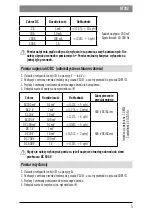
dt202
7
Test ciągłości obwodu
1. Ustawić przełącznik funkcji
O
na pozycję
.
2. Podłączyć czerwony przewód testowy do gniazda V
R
, a czarny przewód do gniazda COM
N
.
3. Nacisnąć przycisk SELECT
L
aby na wyświetlaczu pojawił się symbol
.
4. Przyłożyć przewody pomiarowe do mierzonego obwodu.
5. Ciągłość obwodu zostanie zasygnalizowana sygnałem dźwiękowym przy oporności < 30
.
Przy rezystancji w zakresie 30-100 może pojawić się sygnał dźwiękowy (buzzer). Przy
rezystancji powyżej 100 sygnał dźwiękowy (buzzer) nie pojawia się Napięcie testu:
0,5 V Zabezpieczenie przeciążeniowe: 250 V DC/AC
Wymiana baterii i bezpiecznika
Baterię należy wymienić gdy na wyświetlaczu pojawi się symbol
.
1. Zdjąć tylną pokrywę miernika.
2. Umieścić nowa baterie 2 x AAA zwracając uwagę na prawidłową polaryzację.
Gwarancja
Warunki gwarancji zamieszczone są na stronie: http://www.dpm.eu/gwarancja
Safety guidelines
1. Prior to initiation of device’s usage it is recommended to get thoroughly acquainted with operating
manual and terms of safe use. This will allow avoiding an electric shock, health damages or loss of
life, as well as it may prevent damages to the device.
2. Prior to commencing measurements it is recommended to check for damages on device’s casing or
measuring cables. In case any cable or device damages are detected device should not be used, as
it may pose an electric shock threat.
3. The device should not be used when insulation wrapping the probes and cables is damaged.
4. Only gauging cables delivered with the set may be used for measurements. In case gauging cables
are damaged they should be replaced with cables of exact technical parameters.
5. The device can be used only for measurements compliant with the manual and its technical specifi
-
cation. Otherwise, device’s safety provisions may not be sufficient for safe usage.
6. During measurements all metal ends and gauging slots should not be touched. Fingers should be
kept above insulation sheaths.
7. It is not allowed to make measurements with wet hands or in places with excessive air humidity.
8. It is not recommended to exceed upper limits of electric values given for each gauging range. When
the scale of measured electric value is not known selection of the highest range is recommended for
gauging.
9. It is not recommended to place any electronic elements into gauging slots during voltage measure
-
ments with gauging probes.








































